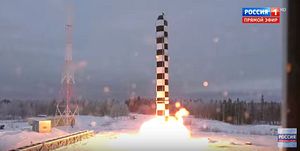Russia is preparing to conduct a number of ejection tests of its most powerful nuclear missile currently under development, the super-heavy thermonuclear-armed intercontinental-range ballistic missile (ICBM) RS-28 Sarmat (NATO designation: SS-X-29 Satan 2).
Preparations for another ejection test are are currently underway at the Plesetsk space center, located in Arkhangelsk Oblast, approximately 800 kilometers north of Moscow, according to the Chief of the General Staff of the Russian Armed Forces General Valery Gerasimov.
“The first launch of this missile took place at the end of December last year. At the moment preparations are in full swing at the Plesetsk cosmodrome for another pop-up test,” he told Russian media on March 13, TASS news agency reports.
An ejection or pop-up launch tests the mechanism of a missile leaving its launch container. The last ejection test took place in December 2017. A test of the Sarmat’s first stage engine, named PDU-99—most likely a modified version of the RD-274 liquid rocket engine used on the RS-36M Vovovoda ICBMs—took place in August 2016.
“With a mass of more than 200 tons it has a shorter active phase of flight and better ability to penetrate missile defenses and can carry warheads of larger mass and enormous yield” Gerasimov added. As I explained last year:
The Sarmat can reportedly carry 10 heavy or 15 (some sources say 16) lighter warheads. The new ICBM can allegedly also be fitted with a new hypersonic glide vehicle (HGV), the YU-71, currently in development under the secret Project 4202. (…) The YU-71 is a warhead purportedly capable of penetrating any Western missile defense system. (…) Each warhead [allegedly] has an explosive yield of up to 750 kilotons.
During his March 1 State of the Union address, Russian President Vladimir Putin said that a new HGV, dubbed Avangard, is already in serial production. The RS-28 Sarmat is slated to enter service by 2020, replacing Soviet era RS-36M Voyevoda ICBMs. However, it is unclear whether the 2020 date will hold as the program has encountered multiple delays.
In a March 12 interview with local media, Russian Deputy Defense Minister Yuri Borisov did not provide a hard induction date for the new ICBM, but spoke in more general terms. “There can be no doubts we will have the new missile Sarmat by the time Voyevoda’s service life is over,” he said. “It is expected that in contrast to its predecessors this missile will be armed with hypersonic warheads, which will make it far harder for defense systems to intercept it.”
































